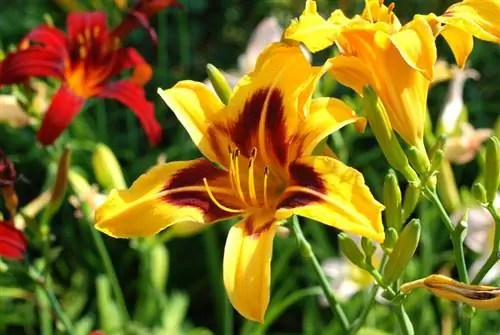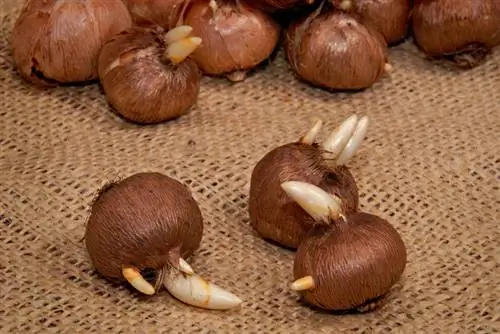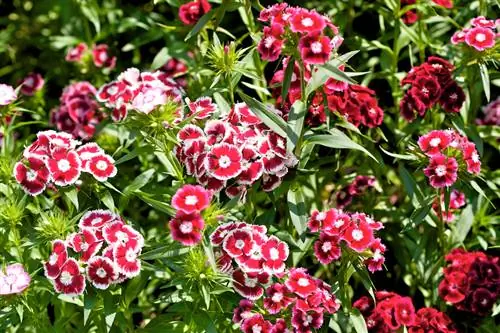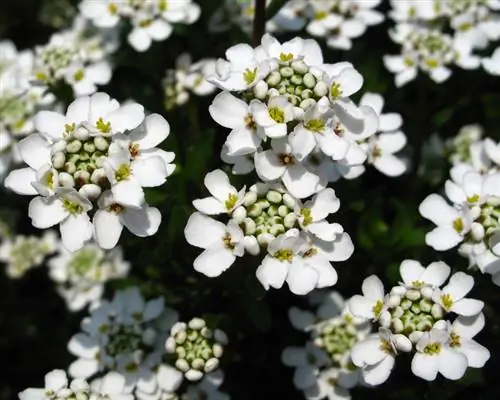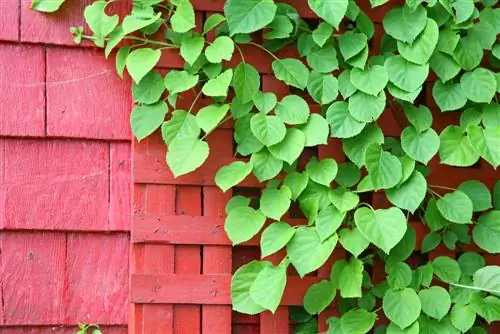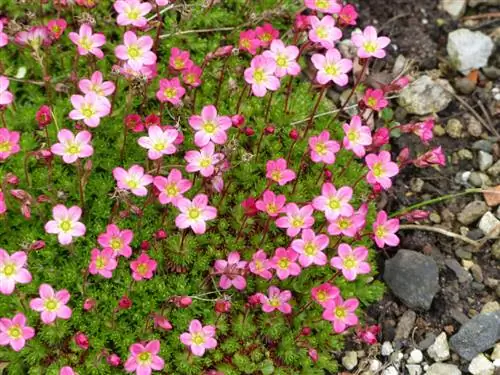- Author admin [email protected].
- Public 2023-12-25 17:45.
- Last modified 2025-01-23 11:22.
Their picturesque blossom lasts just one summer day. When it closes in the evening, the floral successor is already ready. It is no coincidence that daylilies are among the most magnificent ornamental perennials. Find out here how you can get the glamorous performance out of these beauties.
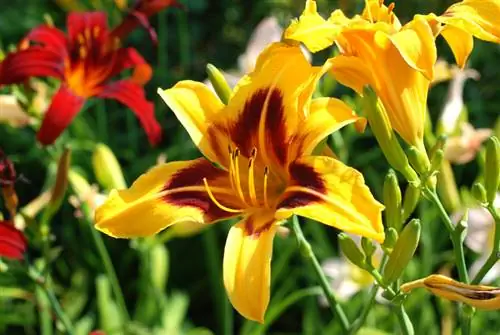
What are the basics of daylily care?
Daylilies (Hemerocallis) are magnificent ornamental perennials that shine in different colors for a flowering period of around 6 weeks. Easy to care for, long-lasting and hardy, they prefer sunny to partially shaded locations with nutrient-rich, well-drained soil.
Planting daylilies correctly
So that the floral daydreams take shape quickly, the following planting procedure makes a significant contribution:
- Time slots are open in April/May and September/October
- Make a pit approx. 30 cm deep in a sunny location
- Spread a drainage layer of gravel or grit on the sole
- Form a small hill over it with soil/compost mix
- Plant the daylily bulb in the middle and cover it with substrate to a maximum height of 5 cm
Finally, water and mulch so that the soil stays warm and moist for longer.read more
Care tips
The summer flower rush of a daylily requires an uncomplicated care program. If you pay attention to the following measures, the perennial will enjoy long-lasting vitality and willingness to bloom:
- Water when dry
- Mulch regularly with grass clippings or bark mulch
- Administer a slow-release fertilizer (€11.00 on Amazon) at the end of April/beginning of May
- Alternatively, fertilize organically every 14 days with compost, guano or plant manure
Cleaning up dead flowers immediately prevents energy-sapping seed formation and prevents self-sowing. Winter protection is recommended in the planting year as well as for daylilies in pots.
Which location is suitable?
The magical ornamental perennials unfold their flowers in lavish abundance if the location meets their requirements as much as possible. These criteria are relevant:
- Sunny to semi-shady location
- nutrient-rich soil, not too dry and with first-class drainage
If you attach importance to maintaining the intense luminosity, the location should not be in the blazing midday sun.read more
When is flowering time?
While the duration of a flowering period is limited to 6 weeks, the flowering time of daylilies depends on the variety chosen. These choices are available:
- Early flowering period: from May to June/July
- Middle flowering period: from June to July/August
- Late flowering period: from August to September/October
read more
Cutting daylilies correctly
Although there is no mandatory need for pruning on daylilies, it can be useful for these reasons.
- As vase decoration
- For use in the kitchen
- For preventing seed heads
- Before or after a division
Regularly cutting out withered leaves and flower heads maintains vitality and has a beneficial effect on new shoots.read more
Fertilize daylily properly
One of the main pillars of professional daylily care is a balanced supply of nutrients. The soil is optimized with compost during planting. From the second year onwards, a suitable fertilizer will replenish the empty energy stores of these ornamental perennials. How to handle it correctly:
- Administer a slow-release fertilizer for flowering plants at the end of April/beginning of May
- Alternatively, fertilize organically every 14 days from April to the beginning of August
- Pamper daylilies in the pot with liquid fertilizer every 2 weeks
From August onwards, fertilization is no longer carried out so that the perennials can mature before winter. This process is supported by targeted fertilization with a potassium-focused agent from the end of June. Supporters of organic fertilization use comfrey manure in this phase.read more
Wintering
A well-established daylily does not require explicit winter protection in the bed. This is particularly true for varieties that come from European breeders. Covering with leaf mold, compost or coniferous twigs is only recommended in the year of planting. However, if you cultivate daylilies in a pot, protection from frost is essential. The exposed location of the roots poses a risk of damage if the substrate freezes completely. This is how you prevent the shortcoming:
- Wrap the pot in bubble wrap or jute before the first frost
- Place on insulating material, such as wood or Styrofoam
- Cut back daylilies to cover the substrate with leaves or straw
If winter comes with frost, the perennials are threatened with drought stress. In this weather there are temperatures below zero, with no snow as a source of moisture. Therefore, water the daylilies on frost-free days.read more
Propagate daylily
It is a matter of honor for the hobby gardener to propagate his daylilies on his own. There are three methods to choose from, each with individual advantages. If you aim for pure offspring that goes hand in hand with rejuvenation, the division of the roots comes into focus. In addition, some species and varieties develop daughter plants in their leaf axils, which are cut out after flowering and planted in loose soil for rooting.
If you have the goal of breeding a new variety or are simply surprised by the result, decide to sow the seeds.read more
How do I transplant correctly?
You have the opportunity to transplant your daylilies twice a year. In early spring or after flowering, the stress of this measure has little effect on the vitality of the ornamental perennial. To minimize damage to the roots, first loosen the soil thoroughly with the digging fork. Then lift the tuber out of the ground.
At the new location, a loose soil enriched with compost awaits the new resident. The planting hole is twice as large as the root ball. Make a small mound in the middle to place the daylily on. Place the flower exactly as deep in the soil as before. Watering and mulching rounds off the entire process.read more
Is daylily poisonous?
Daylilies have been considered a delicacy in China for generations and play a role in medicine. What is good for people is poisonous for pets. Don't let your cat nibble on a daylily as this could have fatal consequences.
Daylily not blooming
If daylilies refuse to bloom, you cannot avoid dedicated research into the cause. The following triggers are possible:
- Light-poor location
- Too big bucket
- Waterlogging
- drought
- Outdated Flower
- Year of Sowing
- Diseases and pests
If the daylily develops numerous leaves without an inflorescence emerging from them, it is over-fertilized. Too much or too nitrogen-containing fertilizer forces foliage growth, which is at the expense of flowers.read more
Sowing the daylily seeds
After flowering, the fruits and seeds ripen within 6-8 weeks. Harvest the seeds on a dry day. Place the seeds in a freezer bag with a piece of Zewa and store them in the vegetable compartment of the refrigerator until spring. This stratification improves the germination of daylily seeds compared to drying. This is how sowing goes successfully:
- Soak the seeds in water for 1 day in February
- Sow in seed soil, sieve thinly and keep moist
- Germination occurs quickly at room temperature in a partially shaded place
If there is a lot of space in the seed container, the seedlings are pricked out. Look after your pupils behind glass until the Ice Saints pass by in May. Only then do you plant the young daylilies in the bed or pot.read more
Dividing the daylily
If a daylily gets old, it becomes lazy to bloom. If it proves to be an outstanding flower beauty, we would like to grow more specimens of it. In both cases, the division is the pivotal point. How to do it right:
- The ideal dates are early spring and autumn
- Take the roots out of the ground with a spade or digging fork and clean them
- Cut into pieces with a sharp knife
- Each segment has at least 2 shoots
Plant the daylily segments immediately at the new or current location and water generously.read more
Is the daylily hardy?
As perennial plants, daylilies have natural winter hardiness. This is particularly true for varieties that were bred in local regions. If your ornamental perennial comes from the USA, frost resistance is not automatically guaranteed. If in doubt, cover flowers with a cover made of leaves, straw or needles before the first frost.
Regardless of their natural hardiness, daylilies in pots receive protection from frosty temperatures. Since the root ball is exposed to the harsh weather, the container should be wrapped tightly and placed on a block of wood. If you apply a potassium fertilizer from June onwards and stop supplying nutrients completely from the beginning of August, you will have a beneficial effect on the degree of frost hardiness.
Are daylilies edible?
Connoisseurs of Chinese cuisine swear by the buds and petals of a daylily as a tasty ingredient or for snacking between meals. All parts of the plant are edible, whether raw, cooked, fried or steamed. The yellow-red daylily (Hemerocallis fulva) is particularly popular with gourmets.read more
Daylily Varieties
Of the almost 60,000 daylily varieties, most varieties come from the USA. Here the magnificent flowers are among the hobby gardeners' favorite perennials. Of course, North American varieties tend to be slow to flower in our cooler climate. Therefore, keep an eye out for daylily varieties that come from local breeders.read more
The most beautiful varieties
- Kwanso: double daylily with brown-red flowers and a height of 70-100 centimeters
- Artic Snow: creamy white flowers with yellowish throat and black stamens
- August Joy: magnificent, yellow-flowering daylily with a long flowering period from July to September
- Bella Lugosi: impresses with extra large, dark red flowers and a yellow-green heart
- Bonanza: decorative eye-catcher thanks to the red-brown star in the middle of golden yellow petals
- Brunette: small-flowered beauty in red-brown for the pot, thanks to a growth height of 50 centimeters
- Chicago Apache: scores with unmissable blood-red flowers from July to September
- Condilla: recommended for container cultivation with a height of 40 centimeters and double, orange-yellow flowers

